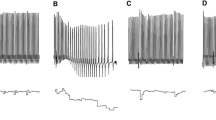Summary
The leatherjacket (Parika scaber) is a balistiform fish which swims using its dorsal and anal median fins. The muscles controlling these fins are well vascularised, with control of blood flow effected by arterioles. These arterioles are long with a single layer of smooth muscle surrounding the endothelium, although the amount of contractile material is sparse, probably a consequence of the low blood pressure. The endothelial cells contain microfilaments, probably contractile, running along the length of the arteriole. The function of this material is unknown.
Similar content being viewed by others
References
Bennett HS, Luft JH, Hampton JC (1959) Morphological classifications of vertebrale blood capillaries. Am J Physiol 196:381–390
Blake RW (1978) On balistiform locomotion. J mar biol Ass UK 58:73–80
Blomqvist CG, Saltin B (1983) Cardiovascular adaptations to physical training. Annu Rev Physiol 45:169–189
Casley-Smith JR (1971) The fine structure of the vascular system of amphioxus: Implications in the development of lymphatics and fenestrated capillaries. Lymphology 4:79–94
Davison W (1987) The swimming muscles of the leatherjacket Parika scaber (Teleostei; Balistidae). Cell Tissue Res 248:131–135
Elger M, Wahlqvist I, Hentschel H (1984) Ultrastructure and adrcncrgic innervation of preglomerular arterioles in the euryhaline teleost Salmo gairdneri. Cell Tissue Res 237:451–458
Ferri S (1981) Ultrastructural identification of smooth muscle cells in the perisinusoidal space of a freshwater teleost fish. Arch Anat Microsc Morphol Exp 70:245–249
Gabella G (1983) Asymmetric distribution of dense bands in muscle cells of mammalian arterioles. J Ultrastruct Res 84:24–33
Honig CR, Odoroff CL, Frierson JL (1982) Active and passive capillary control in red muscle at rest and in exercise. Am J Physiol 243: H196-H206
Johnston IA (1980) Specialisation in fish muscle. In: Development and specialisation of muscle. S.E.B. Seminar Series vol 7, Cambridge University Press, Cambridge, pp 123–148
Johnston IA (1981) Structure and function offish muscles. Symp Zool Soc London 48:71–113
Johnston IA (1983) Dynamic properties of fish muscle. In: Web PW, Weihs D (eds) Fish Biomechanics. Praeger, New York pp 36–67
Johnston IA, Bernard LM, Maloiy GM (1983) Aquatic and aerial respiration rates, muscle capillary supply and mitochondrial volume density in the air-breathing catfish (Clarias mossambicus) acclimated to either aerated or hypoxic water. J Exp Biol 105: 317–338
Leknes IL (1980) Ultrastructure of atrial endocardium and myocardium in three species of Gadidae (Teleostei). Cell Tissue Res 210:1–10
Leknes IL (1981) On the ultrastructure of the endothelium in the bulbus arteriosus of three teleostean species. J Submicrosc Cytol 13:41–46
Mosse PRL (1978) The distribution of capillaries in the somatic musculature of two vertebrate types with particular reference to telost fish. Cell Tissue Res 187:281–303
Mosse PRL (1979) Capillary distribution and metabolic histochemistry of the lateral propulsive musculature of pelagic teleost fish. Cell Tissue Res 203:141–160
Mosse PRL (1980) Vascular anatomy of the lateral musculature of the flathead, Platycephalus bassensis (Teleostei: Perciformes). Zoomorphologie 95:133–148
Neumann P, Holeton GF, Heisler N (1983) Cardiac output and regional blood flow in gills and muscles after exhaustive exercise in rainbow trout (Salmo gairdneri). J Exp Biol 105:1–14
Randall DJ (1970) The circulatory system. In: Hoar WS, Randall DJ (eds) Fish Physiology vol 4. Academic Press, New York
Satchell GH (1971) Circulation in fishes. Cambridge University Press, Cambridge
Satchell GH (1978) Microcirculation in fishes. In: Kaley G, Altura BM (eds) Microcirculation vol 2. University Park Press, Baltimore pp 619–647
Schmidt-Nielsen K (1979) Animal Physiology adaptation and environment. Cambridge University Press, Cambridge
Totland GK, Kryvi H, Bone Q, Flood PR (1981) Vascularisation of the lateral muscle of some elasmobranchiomorph fishes. J Fish Biol 18:223–234
Vyazovoy VV, Matyukhin NA, Neshumova TV, Shoshenko KA (1982) Blood circulation in the red and white skeletal muscles of the Baikal grayling Thymallus arcticus baicalensis (Thymallidae), in relation to swimming speed. J Ichthyol 22:131–137
Weideman MP, Tuma RF, Mayrovitz HN (1981) An introduction to microcirculation. Academic Press, New York
Author information
Authors and Affiliations
Rights and permissions
About this article
Cite this article
Davison, W. Arterioles in the swimming muscles of the leatherjacket Parika scaber (Pisces: Balistidae). Cell Tissue Res. 248, 703–708 (1987). https://doi.org/10.1007/BF00216502
Accepted:
Issue Date:
DOI: https://doi.org/10.1007/BF00216502




